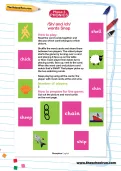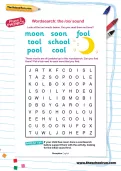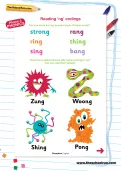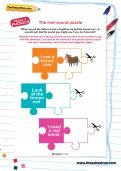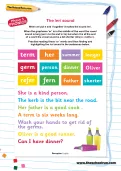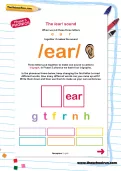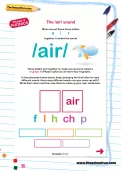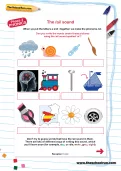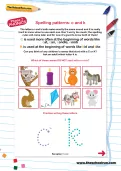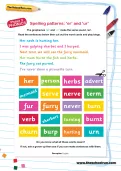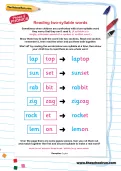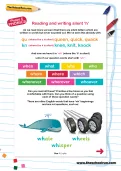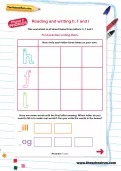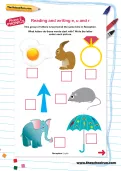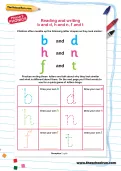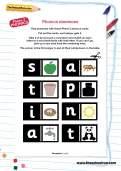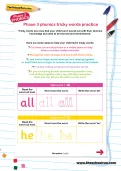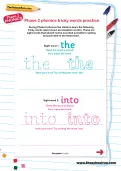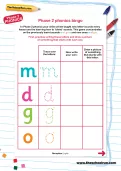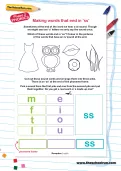When we put the letters o and w together we get the sound /ow/ – it sounds just like the sound you might say if you hurt yourself! Read the sentences in the puzzle pieces and then draw a picture to go
with the sentence. Then cut each of the sentence and picture pieces apart and see if somebody can put them back together again.
or
Register to add to your saved resources
Already a subscriber? to view this content.
Practise reading these ‘er’ words and then finding and highlighting the /er/ sound in the sentences below.
or
Register to add to your saved resources
Already a subscriber? to view this content.
In the phoneme frame, keep changing the first letter to read different /ear/ words. How many different words can you come up with? Write them down and then use them to make up your own sentences then read the short sentences and fill in the missing word.
or
Register to add to your saved resources
Already a subscriber? to view this content.
In the phoneme frame below, keep changing the first letter to read different words. How many different words can you come up with? Write them down and then use them to make up your own sentences. Then have a game of pairs with these /air/, /igh/ and /ear/ sound words.
or
Register to add to your saved resources
Already a subscriber? to view this content.
When we put the letters a and i together we make the phoneme /ai/. Can you write the words under these pictures using the /ai/ sound spelled ‘ai’? Then cut out these words, read them and sort them
into piles of rhyming words.
or
Register to add to your saved resources
Already a subscriber? to view this content.
Which of these words DO NOT start with a c or k? Now cut out and put together these two dice. Roll both dice together and see if when you put the single letter in front of the ending if you get a real word or a silly word.
or
Register to add to your saved resources
Already a subscriber? to view this content.
The graphemes ‘er’ and ‘ur’ make the same sound, /er/. Read the sentences below then cut out the word cards and play bingo
or
Register to add to your saved resources
Already a subscriber? to view this content.
Start off by reading these words one syllable at a time, then show your child how to read them as one whole word. The cut out the jigsaw pieces and see if you can match together the first and second syllable to make a real word.
or
Register to add to your saved resources
Already a subscriber? to view this content.
Lots of our question words start with ‘wh’. Can you read these words? Can you think of a question using each of these question words? Now fill in the gaps in these questions with the right ‘wh’ words.
or
Register to add to your saved resources
Already a subscriber? to view this content.
This worksheet all about these three letters: h, f and l. Here are some words with the first letter missing. Which letter do you need to fill in to make real words? Can you write the words in the boxes? Now read these sentences and answer yes or no.
or
Register to add to your saved resources
Already a subscriber? to view this content.
What letters do these words start with? Write the letter under each picture. Now can you highlight the letters e, ur and r in these words?
or
Register to add to your saved resources
Already a subscriber? to view this content.
Sometimes b gets muddled with d and h gets muddled with n. Can you highlight all the bs and all the ds in two different colours? Now cut out these words and play Pairs or Snap!
or
Register to add to your saved resources
Already a subscriber? to view this content.
Children often muddle up the letter shapes b and d, h and n, f and t as they look similar. Practise writing these letters and talk about why they look similar and what is different about them. Then have a quick game of letter bingo!
or
Register to add to your saved resources
Already a subscriber? to view this content.
Read each of these sentences and then draw a picture that describes what the sentence says.
or
Register to add to your saved resources
Already a subscriber? to view this content.
Play dominoes with these Phase 2 phonics cards. The winner is the first player to put all their cards down on the table
or
Register to add to your saved resources
Already a subscriber? to view this content.
Tricky words are ones that your child can’t sound out with their phonics knowledge but need to be learned and remembered. Here are some ideas to help your child learn tricky words.
or
Register to add to your saved resources
Already a subscriber? to view this content.
These are sight words that should not be sounded out before reading but just need to be memorised. Read the word out loud, then trace the word and finally try writing the word.
or
Register to add to your saved resources
Already a subscriber? to view this content.
Cut out these word cards and play bingo with your child. Sometimes you can be the bingo caller and sometimes they should take a turn.
or
Register to add to your saved resources
Already a subscriber? to view this content.
Play a game of pairs with these ‘z’ and ‘qu’ words. Each player takes it in turn to pick up two words and read them out. If they find the same word, that is a pair and they get to keep them. The winner is the player with most pairs
or
Register to add to your saved resources
Already a subscriber? to view this content.
Which of these words end in ‘ss’? Colour in the pictures of the words that have an /s/ sound at the end.
or
Register to add to your saved resources
Already a subscriber? to view this content.
